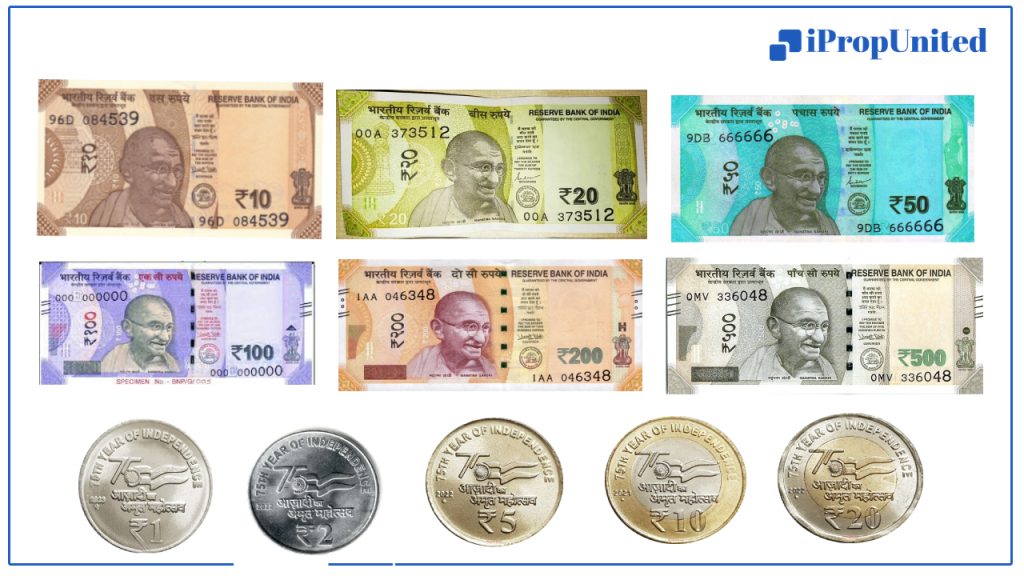The (INR) Indian Rupee is the currency of India. The currency symbol (₹) for the Indian rupee and its INR code is assigned by the International Organization for Standardization.
The rupiya, a silver currency introduced by Sultan Sher Shah Suri in the 16th century, is the origin of the name of the Indian rupee.
Coins
India issues coins in the following denominations: 50 paise, 1 rupee, 2 rupee, 5 rupee, and 10 rupee. Paises are one-hundredth of a rupee. Small coins are those valued at 50 paise or less, whereas rupee coins are those worth one rupee or more.

Banknotes
In the denominations of 5, 10, 20, 50, 100, 500, and 2,000 rupees, paper money or banknotes are produced. While denominations are printed in Hindi and English on the front side of paper rupees, they are printed in 15 other languages on the back.
The design of the banknotes are constantly revised, and there are the noticeable difference between the old Mahatma Gandhi Series banknotes and the current ones with the same name. The notes cover a range of topics related to India’s extensive history.
Rupee Security and Counterfeiting
India has a cash-based economy, which has led to the circulation of counterfeit money by individuals engaging in unlawful activity. Over the years, the Reserve Bank of India (RBI) has been forced to modify and update rupee notes with new security features. Money launderers and terrorist produce counterfeit notes that resemble legal currency. High denomination notes are typically the ones that are counterfeited the most.
The demonetization of all 500 and 1,000 rupee banknotes from the Mahatma Gandhi Series was announced by the Indian government in 2016, with the justification that it would cripple the black market and make it much harder for illegal and counterfeit money to be used to fund crime and terrorism. A new, more secure note from the Mahatma Gandhi Series has been introduced to replace the 500 note.
Special Considerations: Capital and Convertibility Controls
Capital and convertibility controls are special considerations. Over the years, the rupee has been subject to a variety of capitals controls and convertibility limitations. For instance, only small sums of rupees may be imported or exported by Indian nationals, whereas it is prohibited for foreign nationals to do so.
There are no limits on currency conversion for the current account, which consists of the nation’s savings, investment flows, and net commerce in goods and services (aside from trade barriers).
The capital account tracks institutional, business, and foreign exchange flows. To maintain a sound a balanced capital account, the Indian government alternatively loosens and account, the Indian government alternatively loosens and tightens restrictions on foreign investment.
In order to support the declining exchange rate and promote business investment in the nation, the government has recently loosened limitations on foreign investment flow. Both foreign institutional investors and domestic businesses are permitted to enter and exit the country, but they must first confirm the applicable rules and regulations with the Reserve Bank of India.
Rupee’s value in modern times
Large increases in silver production in the 19th century led to a sharp loss in silver’s value, which in turns caused the value of the rupee to fall dramatically. The Indian rupee was linked to the British pound from 1927 until 1946. Then until 1975, it was tied to the dollar. The Reserve Bank of India actively trades the currency to control its value at the moment, as it primarily floats on the foreign exchange market.
Trade flows, investment flows, and oil prices are just a few examples of the many variables that can affect a currency’s exchange rate. Due to its dependence on oil imports, India may experience inflation, necessitating RBI intervention to support the economy.
There are no limits on currency conversion for the current account, which consists of the nation’s savings, investment flows, and net commerce in goods and services (aside from trade barriers).
Example of Indian Rupee
The Reserve Bank of India’s website lists the photos of the current coins and banknotes, together with their denominations, that are currently in use to represent the Indian rupee.
For any updates or modifications, kindly consult the central bank’s website.
Follow and Connect with us: Twitter, Facebook, Linkedin, Instagram







